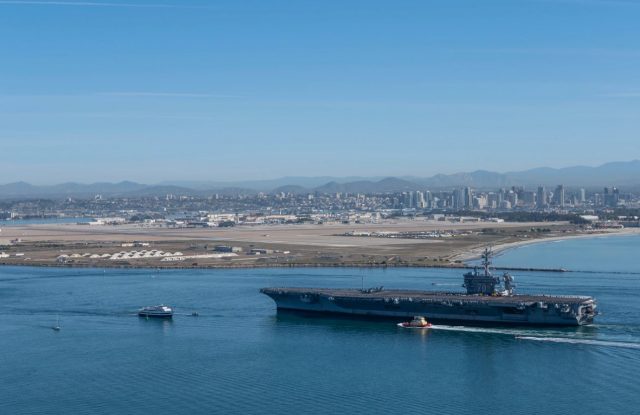The US Navy carrier strike group assigned to aircraft carrier USS Carl Vinson (CVN 70) returned to San Diego on February 14, marking the end of an eight-month deployment to the Pacific and Asia Pacific.
After an accelerated departure from San Diego in August last year, the Carl Vinson CSG supported integrated operations in the Hawaiian Islands operating area with the US Marine Corps, Air Force and Coast Guard as part of the Defense Department’s ongoing presence in the Indo-Pacific region.
They continued into the western Pacific demonstrating US commitment to partnerships and alliances in the region while upholding a free and open Indo-Pacific.
Carl Vinson is the first aircraft carrier to deploy with a combination of fourth and fifth-generation platforms within Carrier Air Wing (CVW) 2 that predominantly represent the “Air Wing of the Future,” including the F-35C Lightning IIs of Strike Fighter Squadron (VFA) 147, and the CMV-22B Ospreys of Fleet Logistics Multi-Mission Squadron (VRM) 30.
Other squadron embarked on the carrier included the F/A-18E/F Super Hornets of VFAs 2, 113, and 192, the EA-18G Growlers of Electronic Attack Squadron (VAQ) 136, the E-2D Advanced Hawkeyes of Airborne Command & Control Squadron (VAW) 113, the MH-60R Sea Hawks of Helicopter Maritime Strike Squadron (HSM) 78, and the MH-60S Sea Hawks of Helicopter Sea Combat Squadron (HSC) 4.
A complete Air Wing of the Future will also include the MQ-25 Stingray unmanned aircraft system, which is planned to be incorporated into carrier air wings in 2025.
During the deployment, the air wing executed more than 15,000 fixed-wing and helicopter flight hours comprising of 7,791 sorties, 7,702 launches and 7,761 aircraft arrestments.
While the navy said the deployment was a successful one, it was not all smooth sailing. In January this year, an F-35C had a landing mishap on the flight deck of the carrier. The pilot safely ejected from the aircraft following a ramp strike but the crash injured seven sailors on board.
“The tireless dedication and professionalism of our sailors, through a global pandemic, challenging operational tempo, and sacrificed time away from family, is truly humbling,” said Capt. P. Scott Miller, commanding officer of Nimitz-class aircraft carrier USS Carl Vinson (CVN 70), the strike group’s flagship. “Their efforts have demonstrated flexibility and resiliency and ensured mission success in every task. They have directly supported a free and open Indo-Pacific and have underscored our Navy’s readiness, strength, and lethality.”
Ships in the Carl Vinson CSG sailed more than 80,000 nautical miles while underway for 262 days, conducted dual carrier operations and multinational exercises, including maritime security operations, integrated training between surface and air units, long-range maritime strike, anti-submarine warfare, information warfare operations, maritime interdiction operations, personnel recovery, air defense operations, multiple ship navigation and formation maneuvering, and refueling-at-sea operations. While deployed, the strike group operated in some of the most heavily navigated waters of the Indo-Pacific including the South China Sea and the Philippine Sea.
The strike group successfully completed operations and exercises alongside multiple partners and allies including navies from Australia, Canada, Germany, India, the Netherlands, New Zealand and the United Kingdom as well as the Japan Maritime Self-Defense Force.
Notable multinational, bilateral, and US-only exercises included Large Scale Exercise 2021 in August, Operation Malabar and Maritime Partnership Exercise 2021 in October, Annual Exercise 2021 in November, US and Australia’s bilateral exercise in December and Expeditionary Strike Force and dual carrier operations in January 2022.
“Alongside our partners and allies, we have aggressively pursued every opportunity to elevate our combat readiness in a drive to continue upholding regional stability,” said Rear Adm. Dan Martin, commander, Carrier Strike Group (CSG) 1. “We’ve been doing this for 75 years and I’m proud to say that our team has relentlessly paid tribute to this legacy with many long hours of sweat and determination that started well before we left San Diego.”



























